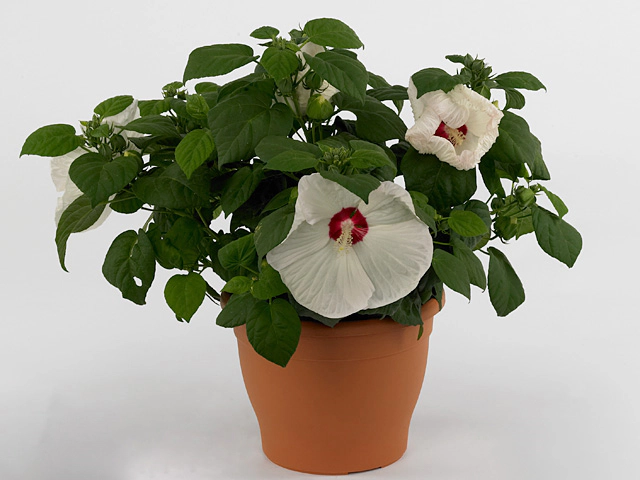Hibiscus moscheutos Guido White Eye

| Leaf arrangement | spreaded |
| Leaf tip | Acuminate |
| Flower type | Single |
| Leaf margin | Entire; Erose |
| Flower scent | Unscented |
| Winter hardness | Excellent (USDA-zone 1,2,3,4) |
| Flower color | White-white-155C |
| Soil fertility | No poor soils |
| Leaf, general shape | Cordate (heart-shaped) |
| Flower diameter | 13 - 14 cm |
| Plant height | 30 - 40 cm; 50 - 60 cm; 60 - 70 cm |
| Flowering month(s) | July; August; September; October |
| Leaf size | 10 - 15 cm |
| Light conditions | Sunny |
| Leaf, main color | Dark green |
| Flower color distribution | With Eye |
| Flower, secondary color(s) | Red-dark purple red-046A |
| Moisture requirements | Well-drained |
| Soil type | Humus rich |
The Hibiscus moscheutos Guido White Eye, also known as the Rose of China, is a stunning flower with a range of attractive features. This article will explore the various characteristics of this particular hibiscus variety.
One of the first notable features of the Guido White Eye is its leaf arrangement. The leaves are spreaded, creating a lush and full appearance. The leaf tips are acuminate, adding a pointed and elongated shape to the foliage. The leaf margin is described as entire and erose, which means it is smooth and undulating.
When it comes to the flower type, the Guido White Eye is categorized as a single flower. The flower has a large diameter of 13 to 14 cm, making it a prominent and eye-catching addition to any garden. The color of the flower is a pure white, specifically categorized as white-white-155C. It is worth noting that the flower also has a distinct feature - an eye, which adds additional visual interest. The eye is a secondary color in red-dark purple red-046A, creating a striking contrast against the white petals. Interestingly, the flower is unscented, which may disappoint those who enjoy the fragrance of flowers.
In terms of its growing conditions, the Hibiscus moscheutos Guido White Eye thrives in well-drained soil. It is important to note that this variety does not do well in poor soils, so it is recommended to provide it with fertile soil enriched with humus. The plant prefers sunny light conditions, so it should be placed in a location where it can receive ample sunlight.
With regards to its winter hardiness, the Guido White Eye is excellent, able to withstand cold temperatures in USDA zones 1, 2, 3, and 4. This makes it a great choice for gardeners in areas with harsh winters.
In terms of size, the plant reaches a height of 30 to 40 cm, 50 to 60 cm, or 60 to 70 cm, depending on its specific growth conditions. The leaves have a general shape described as cordate or heart-shaped, adding a touch of charm to the overall appearance.
Regarding the flowering period, the Guido White Eye blooms from July to October, making it a great addition for late summer and early autumn gardens. The plant's ability to bloom for an extended period adds to its overall appeal.
In conclusion, the Hibiscus moscheutos Guido White Eye, or Rose of China, is a beautiful plant with a range of attractive features. From its large white flowers with a contrasting eye to its heart-shaped leaves and excellent winter hardiness, it offers a captivating addition to any garden. By providing it with well-drained, fertile soil and ample sunlight, gardeners can enjoy the beauty of this unique hibiscus variety for many seasons to come.
Market availability index by month:
| Jan. | Feb. | Mar. | Apr. | May | Jun. | Jul. | Aug. | Sep. | Oct. | Nov. | Dec. |
|---|---|---|---|---|---|---|---|---|---|---|---|
| - | - | - | - | - | 1 | 4 | 3 | 1 | - | 1 | - |